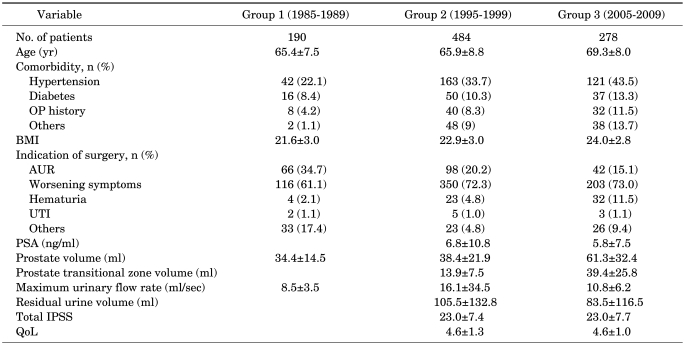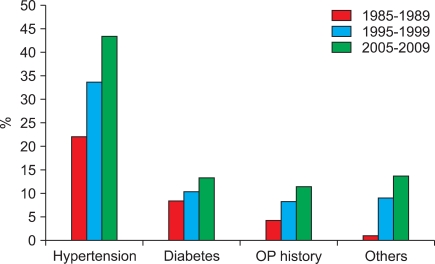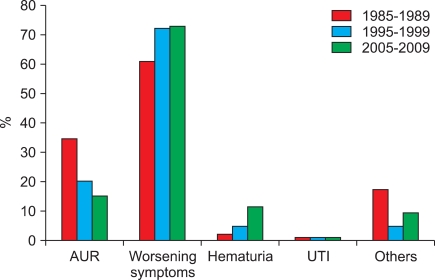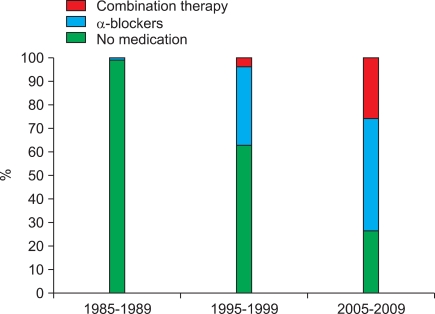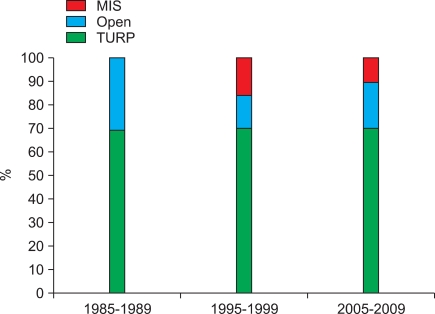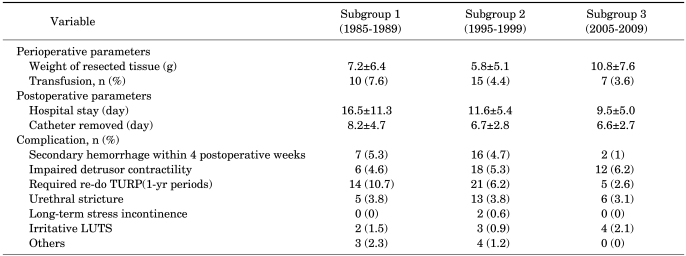Abstract
Purpose
Following the introduction of medical therapy for benign prostatic hyperplasia (BPH), we determined the effect of the change in trends in medical therapy on the indication and outcome of surgical intervention for BPH.
Materials and Methods
We compared the basic characteristics of, weight of resected tissue of, transfusions in, and postoperative complications of patients who underwent surgery between 1985 and 1989 (before the advent of medical therapy for BPH), between 1995 and 1999 (when medical therapy was developed and became widely used as alternative treatment), and between 2005 and 2009 (when medical therapy superseded surgical intervention to become first-line treatment and when combination therapy became widely adopted).
Results
At our institution, the mean age and BMI of patients increased over the past two decades (p<0.001). Hypertension, operation history, and other comorbidities also increased significantly (p<0.001, p=0.005, and p<0.001, respectively). The indications for surgery in 1985 to 1989, 1995 to 1999, and 2005 to 2009 were as follows: acute urinary retention in 34.7%, 20.2%, and 15.1% of patients and symptomatic deterioration in 61.1%, 72.3%, and 73.0% of patients, respectively. Prostate volume and the weight of resected tissue increased from 34.4±14.5 ml to 61.3±32.4 ml and from 7.2±6.4 g to 10.8±7.6 g, respectively, over two decades. Patients who underwent surgery in 2005 to 2009 had their catheters removed earlier (p<0.001). Secondary hemorrhage within four postoperative weeks and repeat transurethral resection of the prostate within 1 year decreased significantly (p=0.03 and p=0.003, respectively). No statistically significant change in impaired detrusor contractility was found (p=0.523).
Conclusions
Although patients who underwent surgery were older after widespread use of medical therapy for BPH, advancements in surgical techniques have benefitted these patients.
Keywords: Benign prostatic hyperplasia, Medical therapy, Surgical intervention
INTRODUCTION
Several decades ago, treatments for benign prostatic hyperplasia (BPH) were almost entirely surgical [1]. During the 1990s, various minimally invasive surgical procedures (MIS) were developed, including transurethral microwave thermotherapy, transurethral needle ablation, and transurethral laser vaporization. Although techniques have advanced, transurethral resection of the prostate (TURP) remains the gold standard surgical intervention for BPH [2].
The introduction of α-antagonists in the early 1990s resulted in significant improvements in the medical treatment of BPH [3]. After the early 2000s, combination therapy with α-antagonists and 5-α-reductase inhibitors has resulted in significant changes in the management of lower urinary tract symptoms (LUTS) secondary to BPH [4]. In the Proscar Long-Term Efficacy and Safety and Medical Therapy of Prostate Symptoms (MTOPS) studies, medical therapy reduced the incidence of urinary retention and the need for invasive surgery [5]. Currently, α-blockers and 5-α-reductase inhibitors are first-line treatments for BPH. Nevertheless, many patients continue to undergo surgical intervention for BPH. Some patients cannot or will not tolerate medical therapy, whereas others experience symptomatic deterioration despite long-term medical therapy.
Despite the advances in medical and surgical intervention, many men continue to suffer from BPH. This condition is associated with a reduction in quality of life (QoL). As the average life expectancy increases, the incidence of BPH also increases. The incidence of BPH is 50% in men between 51 and 60 years of age and as high as 88% in men up to 80 years of age [6]. In an aging population, it would be advantageous to determine the roles of medical and surgical intervention for BPH and the effect of changes in medical therapy trends on the indications and outcomes of surgical intervention for BPH. The aim of this study was to compare the outcomes in patients who underwent surgery in 1985 to 1989 (before the widespread use of medical therapy for BPH), in 1995 to 1999 (when medical therapy was developed and began to be prescribed as alternative treatment to surgery), and in 2005 to 2009 (when medical therapy superseded surgical intervention to become first-line treatment and when combination therapy became widely adopted).
MATERIALS AND METHODS
Medical records were retrospectively reviewed for all patients who underwent surgery for BPH from 1 January 1985 to 31 December 1989 (group 1), from 1 January 1995 to 31 December 1999 (group 2), and from 1 January 2005 to 31 December 2009 (group 3). University staff urologists .with more than 1 year of surgical experience with BPH performed all the operations. Preoperatively, we evaluated age, body mass index (BMI), prostate-specific antigen (PSA) level, prostate volume, prostate transitional zone volume, maximum urinary flow rate, postvoid residual urine volume, International Prostate Symptom Score (IPSS), QoL score, BPH medication use, and chief complaints. Prostate and transitional zone volume were measured by transrectal ultrasonography. Postvoid residual urine volume was measured by ultrasonography. BPH medication history included α-blocker or 5-α-reductase inhibitor therapy for BPH more than 3 months before surgery. Patient comorbidity was evaluated on the basis of premedication history. The type of surgery was classified as open prostatectomy, TURP, or MIS. MIS included transurethral microwave thermotherapy, transurethral needle ablation, and transurethral laser vaporization. Perioperative and postoperative parameters were investigated representatively in patients who underwent TURP, who were divided into 3 subgroups according to time period: 1985 to 1989 (subgroup 1), 1995 to 1999 (subgroup 2), and 2005 to 2009 (subgroup 3). Transfusion and the weight of the resected tissue were evaluated as operative parameters. The postoperative course was evaluated on the basis of length of hospital stay, the postoperative day on which the catheter was removed, and postoperative complications. A postoperative complication was defined as any event requiring additional treatment within 1 year of BPH surgery: secondary hemorrhage that required transfusion or hospital admission within 4 weeks postoperatively, impaired detrusor contractility that required suprapubic cystostomy as a result of recurrent acute urinary retention (AUR) or failure to void, repeat surgery for BPH, urethral stricture that required surgical intervention, long-term stress incontinence, and irritative LUTS that required medication use until 1 year postoperatively.
For the statistical analysis, one-way analysis of variance was used for continuous variables and a chi-square test was used for categorical variables to assess differences between means. A p value <0.05 was considered to be statistically significant. SPSS ver. 18.0 (IBM, New York, NY, USA) was used for the statistical analysis.
RESULTS
The medical records of 952 men were reviewed and included in this study. The basic characteristics of the men are shown in Table 1. A total of 190 men underwent surgery for BPH in group 1, 484 in group 2, and 278 in group 3. The mean ages of the men were 65.4, 65.9, and 69.3 years in group 1, group 2, and group 3, respectively. Over time, the mean age increased and was significantly different between group 2 and group 3 (p<0.001). The comorbidities of patients who underwent surgery for BPH are shown in Fig. 1. The prevalences of hypertension, a history of surgery, and "others" (e.g., stroke, cancer, and cardiac conditions) increased significantly over time. BMI increased gradually over two decades (Table 1). The mean BMIs were 21.6, 22.9, and 24.0 in group 1, group 2, and group 3, respectively (p<0.001). The most common indication for surgery in all groups was worsening symptoms, followed by AUR. The incidence of symptomatic deterioration continued to increase, but the rate of AUR kept decreasing. Other indications for surgery included bladder stones and incidentally detected hydronephrosis (Fig. 2).
TABLE 1.
Basic characteristics of men undergoing surgical therapy for benign prostatic hyperplasia
OP, operation; BMI, body mass index; AUR, acute urinary retention; UTI, urinary tract infection; PSA, prostate-specific antigen; IPSS, International Prostate Symptom Score; QoL, quality of life.
FIG. 1.
The prevalence of comorbidity in patients who underwent surgery for benign prostate hyperplasia over three different time periods. Statistically significant increases in hypertension, operation (OP) history, and others were observed (p<0.001, p=0.005, and p<0.001, respectively).
FIG. 2.
Indications for surgery for benign prostate hyperplasia over three different time periods. Acute urinary retention (AUR) decreased significantly (p<0.001), but worsening symptoms increased significantly (p=0.01). UTI, urinary tract infection.
In group 1, only one PSA level was found in the chart review; therefore, group 1 was excluded from the PSA comparison. The mean PSA levels of group 2 and group 3 were 6.8 and 5.8, respectively; however, they were not significantly different. The mean prostate volume showed a trend similar to that of mean age. There was a slight increasing trend from 34.4 ml to 38.4 ml between group 1 and group 2. However, there was a sharp increase between group 2 and group 3 (p<0.001). We could not elucidate sufficient data to analyze prostate transitional zone volume, maximum urinary flow rate, residual urine volume, total IPSS score, and QoL score in group 1. Therefore, we compared groups 2 and 3, and a significant difference was detected in prostate transitional zone volume (p<0.001) (Table 1).
Only two patients (1.1%) in group 1 required BPH medication; the remaining patients in this group did not receive medical therapy. However, 33.5% of the patients in group 2 used α-blockers. A marked improvement was observed in group 3. α-Blockers were taken by 47.8% of patients, and 25.9% of patients required combined therapy with an α-blocker and a 5-α-reductase inhibitor (Fig. 3).
FIG. 3.
The prevalence of medical therapy before surgery for benign prostatic hyperplasia over three different time periods. The prevalence of α-blockers and combination therapy increased significantly (p<0.001).
TURP was the most commonly performed surgical method during the two decades studied. There were fewer open prostatectomies in groups 2 and 3 than in group 1. On the other hand, MIS had only begun to be performed with group 2 (Fig. 4). Of 952 patients, 664 underwent TURP. The basic characteristics of these patients were similar to those of patients who underwent surgery for BPH (Table 1); however, one difference was that the mean prostate volume gradually and significantly increased over the 20-year study period (p<0.001).
FIG. 4.
The types of surgery performed for benign prostatic hyperplasia over three different time periods. Transurethral resection of the prostate (TURP) was used most frequently over all three time periods. MIS, minimally invasive surgery.
We analyzed perioperative and postoperative parameters in subgroups who underwent TURP for direct comparison in one type of surgery: 131 patients in subgroup 1,339 patients in subgroup 2, and 194 patients in subgroup 3 underwent TURP for BPH. Perioperative parameters and postoperative variables for the three patient subgroups are illustrated in Table 2. The mean weight of resected tissue was significantly greater in subgroup 3 than in subgroup 1 and subgroup 2. The number of patients who required transfusion because of perioperative hemorrhage continuously deceased over time. Over time, catheters were removed earlier and patients were discharged earlier after their operations. Secondary hemorrhage within four postoperative weeks and the need for repeat TURP within 1 year after surgery decreased significantly (p=0.03 and p=0.003, respectively). The number of patients who required suprapubic cystostomy gradually increased over time, albeit not significantly so (p=0.523). No significant changes in any of the other complications were found in the three studied periods.
TABLE 2.
Incidence of perioperative and postoperative variables in men undergoing TURP for BPH
TURP, transurethral resection of the prostate; BPH, benign prostatic hyperplasia; LUTS, lower urinary tract symptom.
DISCUSSION
Over the past two decades, medical therapy has been the standard first-line therapy for BPH [5,7]. The conclusion of the Korean study was similar to that of the MTOPS study [8]. Long-term combination therapy reduced the incidence of AUR and BPH surgery. In our study, AUR decreased significantly, but worsening symptoms increased significantly. Our results confirmed an increasing trend in α-blocker monotherapy and combination therapy with 5-α-reductase inhibitors after the 1990s, when medical therapy became widespread. This finding was in line with global trends. However, surgery for BPH is still required and TURP became the mainstay of surgical intervention for BPH. Although medical therapy is appropriate for patients with symptomatic BPH, it has obvious limitations. Failure of medical therapy results in worsening LUTS and recurrent AUR. In this study, the most common chief complaint was worsening symptoms followed by AUR. In a study by Izard and Nickel [9], chronic urinary retention increased substantially, from 14.6 to 39.3 between 1988 and 2008.
Our hypothesis was that medical therapy for BPH would delay surgical intervention. Patients who finally required surgery were inevitably older, had worse health conditions, and had more advanced disease. Therefore, late surgical intervention could result in poorer outcomes associated with worse postoperative complications. In this study, the mean age of patients who underwent surgery was greater in the 1990s than in the 1980s, and the increase was larger after 10 years. As medical therapy became more common, the mean age increased. This trend was also shown in another study. According to Vela-Navarrete et al. [10], patients who underwent surgery for BPH in 2002 were significantly older than those who underwent surgery in 1992, by a mean of 3.1 years. Anamnesis also increased with mean age. A considerable number of patients had hypertension and previous surgical and other medical histories in the 2000s. We concluded that the increasing comorbidity was due to aging, advancement in diagnostic techniques, and increasing health concerns. A higher BMI is associated with a higher risk of comorbidity [11,12]. The decreased AUR and the increased frequency of symptomatic deterioration were due to combination therapy that reduced AUR [8].
According to our results, the mean prostate volume increased during the 20 year period in patients who underwent surgical intervention for BPH. A review by Han et al. [13] showed that the mean prostate volume in surgically managed patients over 5 successive years increased significantly, from 37.1 ml to 53.6 ml, between 1998 and 2002. They attributed these findings to the priority given to medical therapy by patients who required surgery in the past and to development of the endoscopic technique, which extended the indication of TURP. Because of larger prostate volumes, it is natural that the weight of the resected tissue increased correspondingly. This study showed that the mean prostate volume was significantly greater in group 3 than in group 1; simultaneously, the weight of the resected tissue was also significantly greater in subgroup 3 than in subgroup 1. Shin and Park [14] reported that the mean resection volume increased with both TURP and open prostatectomy between 1999 and 2010. Reich et al. [15] evaluated 10,654 patients who underwent TURP and showed that mortality and morbidity were closely associated with the weight of tissue resected. According to Mebust et al. [16], increased morbidity was seen in patients with a gland size greater than 45 g and an age greater than 80 years. According to our survey of perioperative and postoperative variables, the length of hospital stay, the number of days to catheter removal, and the number of transfusions, secondary hemorrhages, and repeat TURPs deceased with time. These findings were due to advancements in surgical techniques, experience, and improved instruments [17]. We believed that critical outcomes such as impaired detrusor contractility would be poor and hypothesized that long-term bladder outlet obstruction would impair bladder detrusor contractility. Saito et al. [18] experimented with rat bladders and found that whole-bladder pressure was significantly lower in rats subjected to long-term outflow obstruction than in controls. However, the number of suprapubic cystostomies required after TURP did not increase significantly, because new techniques and equipment reduced the number of complications and overcame the risks associated with aging [14,17]. In addition, combination therapy resolved bladder outlet obstruction and protected progress to impaired detrusor contractility [8,19]. The results showed that surgical intervention conferred benefits to patients, despite their older ages and larger prostate volumes at the time of surgery.
Our analysis of data spanning two decades was limited by selection bias. We surveyed all patients who had undergone surgery for BPH. Following the widespread adoption of medical therapy for the treatment of BPH, the rate of medical therapy increased and the number of surgeries decreased [13,20]. Although this study did not represent all BPH patients, it analyzed data spanning two decades to determine the changing trends in surgery for BPH. However, because of its retrospective nature, IPSS and transitional zone volume data were not available in the 1980s. An additional limitation was the lack of pre- and postoperative data, such as IPSS data and maximum urinary flow rates, with which to compare the direct results of surgery. Furthermore, we were unable to determine the length of time required to complete the surgeries-a variable that is useful in determining the skill level of surgeons when resection weights are identical. Instead, we used transfusion history in the perioperative period to indirectly determine the level of surgical skill and care. The length of hospital stay appeared to be longer in the current study than in other studies [9,10,21], which was due to Korean health insurance policies and patient tendencies. The mean number of hospitalizations in subgroup 3 in the current study was similar to that in other Korean publications [22,23].
Recently, surgical intervention began evolving as medical treatment. New technologies such as laser and bipolar electrodes have been widely used. Several studies reported that these technologies have led to shorter hospital stays, shorter catheterization periods, and fewer complications [17,24]. Even in patients with large prostate volumes, in whom TURP was inappropriate in the past, these procedures have shown excellent results, especially concerning perioperative blood loss [25]. Continued advancement in surgical intervention is expected to overcome challenges due to aging and large prostate volume.
CONCLUSIONS
The ages and comorbidities of patients who underwent surgery for BPH increased over the two decades studied. Our study showed that the mean prostate volume at the time of surgery was significantly greater than it was 20 years ago, as was the weight of the resected tissue. Although these conditions can increase the risk of complications, the prevalence of secondary hemorrhage within four postoperative weeks and the need for repeat TURP within 1 year after surgery decreased significantly. Furthermore, no significant differences in the prevalence of other complications were observed. Although patients who underwent surgery were older after widespread use of medical therapy for BPH, advancements in surgical techniques have benefitted these patients.
Footnotes
The authors have nothing to disclose.
References
- 1.Flanigan RC, Reda DJ, Wasson JH, Anderson RJ, Abdellatif M, Bruskewitz RC. 5-year outcome of surgical resection and watchful waiting for men with moderately symptomatic benign prostatic hyperplasia: a Department of Veterans Affairs cooperative study. J Urol. 1998;160:12–16. [PubMed] [Google Scholar]
- 2.Reich O, Gratzke C, Stief CG. Techniques and long-term results of surgical procedures for BPH. Eur Urol. 2006;49:970–978. doi: 10.1016/j.eururo.2005.12.072. [DOI] [PubMed] [Google Scholar]
- 3.Chung BH, Yang KM, Hong SJ. Meta-analysis of alpha receptor antagosist for benign prostatic hyperplasia from papers that were published in Korea. Korean J Urol. 2005;46:252–258. [Google Scholar]
- 4.Lepor H, Auerbach S, Puras-Baez A, Narayan P, Soloway M, Lowe F, et al. A randomized, placebo-controlled multicenter study of the efficacy and safety of terazosin in the treatment of benign prostatic hyperplasia. J Urol. 1992;148:1467–1474. doi: 10.1016/s0022-5347(17)36941-0. [DOI] [PubMed] [Google Scholar]
- 5.McConnell JD, Roehrborn CG, Bautista OM, Andriole GL, Jr, Dixon CM, Kusek JW, et al. The long-term effect of doxazosin, finasteride, and combination therapy on the clinical progression of benign prostatic hyperplasia. N Engl J Med. 2003;349:2387–2398. doi: 10.1056/NEJMoa030656. [DOI] [PubMed] [Google Scholar]
- 6.Berry SJ, Coffey DS, Walsh PC, Ewing LL. The development of human benign prostatic hyperplasia with age. J Urol. 1984;132:474–479. doi: 10.1016/s0022-5347(17)49698-4. [DOI] [PubMed] [Google Scholar]
- 7.Clifford GM, Farmer RD. Medical therapy for benign prostatic hyperplasia: a review of the literature. Eur Urol. 2000;38:2–19. doi: 10.1159/000020246. [DOI] [PubMed] [Google Scholar]
- 8.Chang HS, Park CH, Kim CI. Comparison of the long term effect of alpha-blocker only and 5-alpha reductase inhibitor combination treatment on acute urinary retention and prostatic surgery for patients with benign prostatic hyperplasia. Korean J Urol. 2006;47:7–12. [Google Scholar]
- 9.Izard J, Nickel JC. Impact of medical therapy on transurethral resection of the prostate: two decades of change. BJU Int. 2010;108:89–93. doi: 10.1111/j.1464-410X.2010.09737.x. [DOI] [PubMed] [Google Scholar]
- 10.Vela-Navarrete R, Gonzalez-Enguita C, Garcia-Cardoso JV, Manzarbeitia F, Sarasa-Corral JL, Granizo JJ. The impact of medical therapy on surgery for benign prostatic hyperplasia: a study comparing changes in a decade (1992-2002) BJU Int. 2005;96:1045–1048. doi: 10.1111/j.1464-410X.2005.05735.x. [DOI] [PubMed] [Google Scholar]
- 11.Kuczmarski RJ, Carroll MD, Flegal KM, Troiano RP. Varying body mass index cutoff points to describe overweight prevalence among U.S. adults: NHANES III (1988 to 1994) Obes Res. 1997;5:542–548. doi: 10.1002/j.1550-8528.1997.tb00575.x. [DOI] [PubMed] [Google Scholar]
- 12.Barreto SM, Passos VM, Firmo JO, Guerra HL, Vidigal PG, Lima-Costa MF. Hypertension and clustering of cardiovascular risk factors in a community in Southeast Brazil--The Bambui Health and Ageing Study. Arq Bras Cardiol. 2001;77:576–581. doi: 10.1590/s0066-782x2001001200008. [DOI] [PubMed] [Google Scholar]
- 13.Han KS, Hong SJ, Chung BH. Changing trends in the management of bengin prostatic hyperplasia during recent 5 years. Korean J Urol. 2005;46:458–462. [Google Scholar]
- 14.Shin YS, Park JK. Changes in surgical strategy for patients with benign prostatic hyperplasia: 12-year single-center experience. Korean J Urol. 2011;52:189–193. doi: 10.4111/kju.2011.52.3.189. [DOI] [PMC free article] [PubMed] [Google Scholar]
- 15.Reich O, Gratzke C, Bachmann A, Seitz M, Schlenker B, Hermanek P, et al. Morbidity, mortality and early outcome of transurethral resection of the prostate: a prospective multicenter evaluation of 10,654 patients. J Urol. 2008;180:246–249. doi: 10.1016/j.juro.2008.03.058. [DOI] [PubMed] [Google Scholar]
- 16.Mebust WK, Holtgrewe HL, Cockett AT, Peters PC. Transurethral prostatectomy: immediate and postoperative complications. A cooperative study of 13 participating institutions evaluating 3,885 patients. J Urol. 1989;141:243–247. doi: 10.1016/s0022-5347(17)40731-2. [DOI] [PubMed] [Google Scholar]
- 17.Starkman JS, Santucci RA. Comparison of bipolar transurethral resection of the prostate with standard transurethral prostatectomy: shorter stay, earlier catheter removal and fewer complications. BJU Int. 2005;95:69–71. doi: 10.1111/j.1464-410X.2005.05253.x. [DOI] [PubMed] [Google Scholar]
- 18.Saito M, Ohmura M, Kondo A. Restoration of rat bladder function following release of short- and long-term partial outflow obstruction. Urol Res. 1997;25:193–197. doi: 10.1007/BF00941982. [DOI] [PubMed] [Google Scholar]
- 19.Boyle P, Roehrborn C, Harkaway R, Logie J, de la Rosette J, Emberton M. 5-Alpha reductase inhibition provides superior benefits to alpha blockade by preventing AUR and BPH-related surgery. Eur Urol. 2004;45:620–626. doi: 10.1016/j.eururo.2003.09.012. [DOI] [PubMed] [Google Scholar]
- 20.Wasson JH, Bubolz TA, Lu-Yao GL, Walker-Corkery E, Hammond CS, Barry MJ. Transurethral resection of the prostate among medicare beneficiaries: 1984 to 1997. For the Patient Outcomes Research Team for Prostatic Diseases. J Urol. 2000;164:1212–1215. [PubMed] [Google Scholar]
- 21.Borth CS, Beiko DT, Nickel JC. Impact of medical therapy on transurethral resection of the prostate: a decade of change. Urology. 2001;57:1082–1085. doi: 10.1016/s0090-4295(01)01018-4. [DOI] [PubMed] [Google Scholar]
- 22.Kim TS, Choi S, Rhew HY, Ahn JH, Jang JH, Cho MH. Comparative study on the treatment outcome and safety of TURP, ILC, TUNA and TEAP for patients with benign prostatic hyperplasia. Korean J Urol. 2006;47:13–19. [Google Scholar]
- 23.Kwon JS, Lee JW, Lee SW, Choi HY, Moon HS. Comparison of effectiveness of monopolar and bipolar transurethral resection of the prostate and open prostatectomy in large benign prostatic hyperplasia. Korean J Urol. 2011;52:269–273. doi: 10.4111/kju.2011.52.4.269. [DOI] [PMC free article] [PubMed] [Google Scholar]
- 24.Tan AH, Gilling PJ. Lasers in the treatment of benign prostatic hyperplasia: an update. Curr Opin Urol. 2005;15:55–58. doi: 10.1097/00042307-200501000-00013. [DOI] [PubMed] [Google Scholar]
- 25.Bhansali M, Patankar S, Dobhada S, Khaladkar S. Management of large (>60 g) prostate gland: PlasmaKinetic Superpulse (bipolar) versus conventional (monopolar) transurethral resection of the prostate. J Endourol. 2009;23:141–145. doi: 10.1089/end.2007.0005. [DOI] [PubMed] [Google Scholar]



